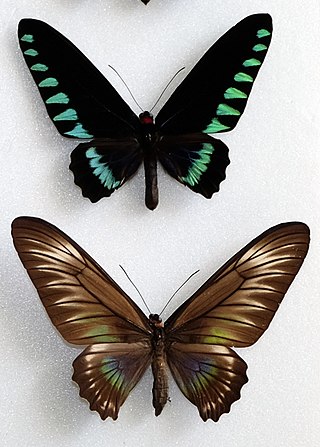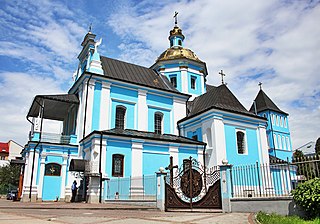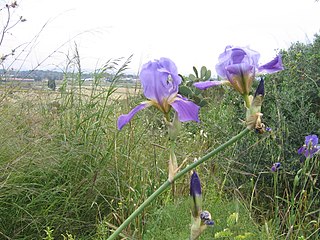
A land mine is an explosive device concealed under or on the ground and designed to destroy or disable enemy targets, ranging from combatants to vehicles and tanks, as they pass over or near it. Such a device is typically detonated automatically by way of pressure when a target steps on it or drives over it, although other detonation mechanisms are also sometimes used. A land mine may cause damage by direct blast effect, by fragments that are thrown by the blast, or by both. Landmines are typically laid throughout an area, creating a minefield which is dangerous to cross.

Mining is the extraction of valuable geological materials from the Earth and other astronomical objects. Mining is required to obtain most materials that cannot be grown through agricultural processes, or feasibly created artificially in a laboratory or factory. Ores recovered by mining include metals, coal, oil shale, gemstones, limestone, chalk, dimension stone, rock salt, potash, gravel, and clay. Mining in a wider sense includes extraction of any non-renewable resource such as petroleum, natural gas, or even water.

A naval mine is a self-contained explosive device placed in water to damage or destroy surface ships or submarines. Unlike depth charges, mines are deposited and left to wait until they are triggered by the approach of, or contact with, any vessel or a particular vessel type, akin to anti-infantry vs. anti-vehicle mines. Naval mines can be used offensively, to hamper enemy shipping movements or lock vessels into a harbour; or defensively, to protect friendly vessels and create "safe" zones. Mines allow the minelaying force commander to concentrate warships or defensive assets in mine-free areas giving the adversary three choices: undertake an expensive and time-consuming minesweeping effort, accept the casualties of challenging the minefield, or use the unmined waters where the greatest concentration of enemy firepower will be encountered.

Trojane is a settlement in the Municipality of Lukovica in central Slovenia. It lies in the northern part of the Sava Hills, on a hill near the border of two Slovene regions, Carniola and Styria. Until the freeway was finished in 2005, Trojane was on the main route from Ljubljana to Maribor.

Quercus trojana, the Macedonian oak is an oak in the turkey oak section (Quercus sect. Cerris).

Trogonoptera is a genus of birdwing butterflies from the rainforests of the Thai-Malay Peninsula, Borneo, Natuna, Sumatra, Palawan, and various small islands west of Sumatra. Their large size and stunning colors makes them highly prized by collectors. There are at least three theories as to why these butterflies have such distinctive markings on their wings: (1) the alternate green/black spear shapes mimic sharp thorns; (2) the green spear shapes mimic the camouflage pattern of a fern leaf when the butterfly is resting; (3) when flying, the black and green markings mimic those of green broadbill bird feathers in flight. The three green broadbill species in Borneo are found in the same habitats as Rajah Brooke's birdwing, which occurs from the forested lowlands up to 2.000 m on Mount Kinabalu. A number of observers have noted that all Borneo’s birdwing butterflies are so large that they are easily mistaken for birds in flight. A bird hunting for an insect to eat would be unlikely to attack a bird. If the butterfly wing pattern mimics the broadbill’s feathers then it would be a case of a Mullerian mimicry ring because both species have wings covered with thorn like patterns. In addition the broadbills are protected because of their large beaks and the butterfly because it is poisonous. The blue colors evolved in Trogonoptera brookiana form hecata and Trogonoptera trojana may be explained by the presence of fairy-bluebirds in their habitat.

The Pindus Mountains mixed forests constitute a terrestrial ecoregion of Europe according to both the WWF and Digital Map of European Ecological Regions by the European Environment Agency. It belongs to the Mediterranean forests, woodlands, and scrub biome, and is in the Palearctic realm.

Trogonoptera trojana, the Palawan birdwing or triangle birdwing, is a birdwing butterfly of the family Papilionidae. It is endemic to Palawan in the Philippines. It is one of only two species in its genus, the other being the more widespread Rajah Brooke's birdwing, where the male has larger green markings on the hindwings. This species is included in CITES Appendix II, restricting international export to those who have been granted a permit. The wingspan is approximately 18–19 cm (7.1–7.5 in). The species may be observed flying at any point during the year. The larvae feed on Aristolochia.

The Tyrrhenian-Adriatic sclerophyllous and mixed forests is an ecoregion in southern Italy, Sicily, Sardinia, Corsica, the Dalmatian Islands of Croatia, and Malta.
Stigmella szoecsiella is a moth of the family Nepticulidae. It is found in Hungary, Italy, Greece and Turkey.
Stigmella zangherii is a moth of the family Nepticulidae. It is widespread in south-eastern Europe and Turkey, in the north to the Czech Republic and Slovakia, in the west a single specimen was recorded from south-eastern France. There are further records from eastern Austria, Hungary, mainland Italy, Sicily, Slovenia, Croatia, Yugoslavia, Greece and Turkey.
Stigmella trojana is a moth of the family Nepticulidae. It is found in northern Greece and Turkey.
Ectoedemia gilvipennella is a moth of the family Nepticulidae. It is found from the Czech Republic and Slovakia to Italy and Greece.

Phyllonorycter quercifoliella is a moth of the family Gracillariidae. It is known from all of Europe, except for the Mediterranean islands.

Bucculatrix ulmella is a moth of the family Bucculatricidae. It is found in most of Europe, except the Iberian Peninsula, Slovenia and Bulgaria. It was first described in 1848 by Philipp Christoph Zeller.

Iris junonia is a plant species in the genus Iris, it is also in the subgenus Iris. It is a rhizomatous perennial, from Cilicia, within the Taurus Mountains. It has glaucous short leaves, tall stems with several branches, numerous flowers in various colours from blue-purple, lavender, pale blue, cream, white and yellow, with brown veining and white tipped orange beards. It is cultivated as an ornamental plant in temperate regions. Its status is still unclear, if it is a synonym of Iris germanica or a separate species.

The Church of the Nativity of the Theotokos is a historic Greek Catholic church in Sambir, in the Lviv region of Ukraine.

Iris mesopotamica, the Mesopotamian iris, is a species in the genus Iris, it is also in the subgenus Iris. It is a rhizomatous perennial, from the middle East, within the countries of Iraq, Turkey, Syria and Israel. It has linear, grey-green or green broad leaves, tall stem with 2–3 branches, holding up to 9 scented flowers, in shades of violet, purple, lavender blue and light blue, with a yellow and white or orange and white beard. It is listed as a synonym of Iris germanica in some sources. It is cultivated as an ornamental plant in temperate regions, including being planted in graveyards and cemeteries but may also be used for celebrations and decoration.
Eurhodia is a genus of echinoderms belonging to the family Cassidulidae.

The Bulgëri are a historical Albanian tribe (fis) and tribal region in the districts of Lezha and Mirdita of northern Albania. It is one of the four traditional bajraks of the Highlands of Lezha, alongside the Kryezezi, Vela and Manatia.














